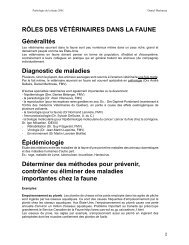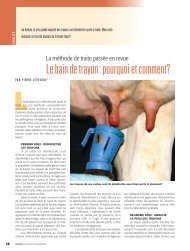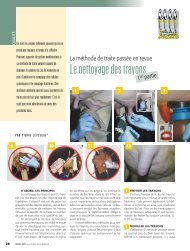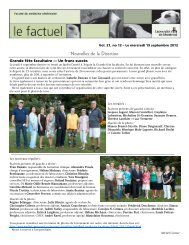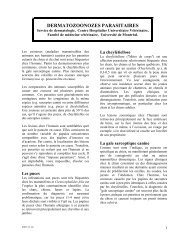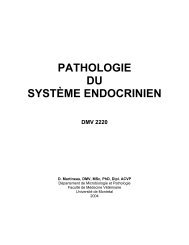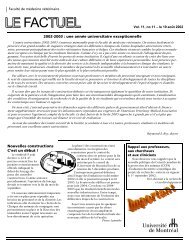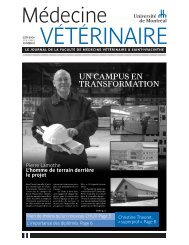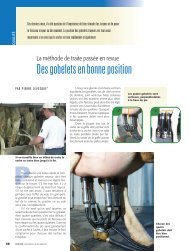Bedding Choices Mastitis Control and Cow Comfort
Bedding Choices Mastitis Control and Cow Comfort
Bedding Choices Mastitis Control and Cow Comfort
You also want an ePaper? Increase the reach of your titles
YUMPU automatically turns print PDFs into web optimized ePapers that Google loves.
<strong>Bedding</strong> <strong>Choices</strong><strong>Mastitis</strong> <strong>Control</strong> <strong>and</strong> <strong>Cow</strong> <strong>Comfort</strong>The purpose of bedding for housed dairy cattle istwo-fold: cow comfort <strong>and</strong> mastitis control. Thestall base must provide adequate cushion to relievepressure points from bony prominences. Paddedmattresses can provide this, but use of mattressesdoes not eliminate the need for bedding. <strong>Bedding</strong>material also reduces the friction from the surfaceof the mattress. Without bedding, hock lesions willdevelop <strong>and</strong> can lead to significant lameness.Teat end exposure to mastitis causing bacteria isthe root of all mastitis problems. When the cow isst<strong>and</strong>ing, the probability for exposure is minimal.Eventually, cows will find a place to lie down, placingtheir teat ends in jeopardy. To help reduce newintramammary infections, bedding must be able toabsorb moisture <strong>and</strong> help decrease teat end bacterialcontamination.Many factors are involved in selection of suitablebedding materials including cost, availability, facilitiesdesign, cow comfort, ease of use, manure storage<strong>and</strong> disposal. Here are the strengths <strong>and</strong> weaknessof each common type of bedding material:3 Sawdust <strong>and</strong> shavings: Wood-based productsare the most popular bedding material choicesfor dairy producers but the availability of kilndried sawdust <strong>and</strong> wood shavings can be limitedin some areas. Wood products provide good cowcomfort <strong>and</strong> work well in most waste managementsystems. The biggest disadvantage is that sawdust<strong>and</strong>/or wood shavings provide an environment formastitis-causing microorganisms. Use of green,hardwood sawdust containing bark material hasbeen associated with Klebsiella mastitis. Bacterialnumbers often increase with decreasing particlesize. Very fine sawdust from furniture constructionmay be nearly sterile prior to use but thesmall particle size supports very rapid growthof bacteria requiring more intensive beddingmaintenance. Materials of fine particle size aremore likely to cake on the teat skin leading to highpopulation of bacteria on the teats <strong>and</strong> greater opportunitiesfor intramammary infection. Woodproducts such as shavings, which have a muchlarger particle size, do not tend to cling to teatskin <strong>and</strong> support slower growth of bacteria.3 Straw. Long straw has been used successfully incalving pens. Straw must be chopped to work wellin stalls. Straw, whether long or chopped can betoo bulky for many manure systems. Use of strawbedding is often associated with increased levelsof mastitis from Streptococcus uberis infections.3 Paper. Paper products are relatively inert initially.The biggest drawback is that they tend to stick tocows <strong>and</strong> mat up when they get damp with urineor moisture. Bacterial numbers can increasewithin 24 hours of contamination. Some manuresystems actually h<strong>and</strong>le paper better than otherwood products.3 Hulls. Rice hulls provide comfortable beddingfor cattle. Hulls can be relatively inexpensive,easy to h<strong>and</strong>le, <strong>and</strong> work well in liquid-manureh<strong>and</strong>ling systems. The big disadvantage is that ricehulls can have high carbohydrate levels, whichreadily support the growth of microorganismsthat cause mastitis. Rice hulls have been shownto be a better medium for microbial growth thanany of the more commonly used organic beddingmaterials.3 Composted or dried manure solids have also beenadvocated as bedding material. They have beenused successfully on some farms where weatherconditions contribute to a very dry environmentfor most of the year. These materials are usuallyfree of most major environmental mastitispathogens when initially applied. However, driedmanure is an excellent medium for bacterialgrowth once moisture from urine <strong>and</strong> fresh manureare added. Wet <strong>and</strong> hot, humid conditionsare not conducive to the effective use of driedmanure solids or composted dairy waste as a beddingmaterial for this reason. Composting offerslittle benefit in reducing teat end contaminationby coliform bacteria in dairy waste solids. Thismay be due to the fine particle size <strong>and</strong> the smallermanure particles clinging to teat skin.3 Recycled manure solids. With the advent of methanedigesters, recycled manure solids have grown
in popularity. One advantage is the eliminationof the finer manure solids from the beddingcomponent. This creates a fluffier material thatreduces compaction <strong>and</strong> is less able to cling toteat skin. Although the moisture level comingoff the digester is rather high (about 70%), useof the fresh product on a daily basis can provideexcellent bedding. The types of bacteria neededto produce methane are typically not commonlyfound when culturing cows with mastitis. Yet,even this bedding source can become contaminatedquickly when fresh manure, urine <strong>and</strong>/ormilk are added.3 S<strong>and</strong>. Many consider s<strong>and</strong> to be the gold st<strong>and</strong>ardof bedding materials. It is inert <strong>and</strong> does notsupport the growth of bacteria. S<strong>and</strong> should beof builders’ quality <strong>and</strong> contain little or no silt orclay. When properly maintained, s<strong>and</strong> providesa very comfortable medium for bedding. S<strong>and</strong>particles tend to move rather than compact,forming a more comfortable resting surface thatconforms to the cow’s body. Bacteria counts ofused s<strong>and</strong> bedding are often significantly lowerthan in organic bedding materials. Lower bacteriacounts are associated with reduced rates of newinfections with environmental pathogens. A bigdisadvantage to using s<strong>and</strong> is that it settles at thebottom of lagoons <strong>and</strong> manure collection pits <strong>and</strong>can cause excessive wear on manure spreaders,pumps, <strong>and</strong> separators.Differential bacterial counts can be useful forevaluating bedding quality <strong>and</strong> management. Bothused <strong>and</strong> unused bedding should be evaluated. Tocollect used bedding samples several ounces ofmaterial should be collected from the last 16 inchesof the rear of the stall surface. Select at least six ormore typical stalls. The material should be placed ina zip-lock bag <strong>and</strong> labeled. Refrigerate the samples<strong>and</strong> send them to the lab on ice packs.source: Richard L. Wallace, University of Illinois© Dairyman’s Digest, Summer 2007



